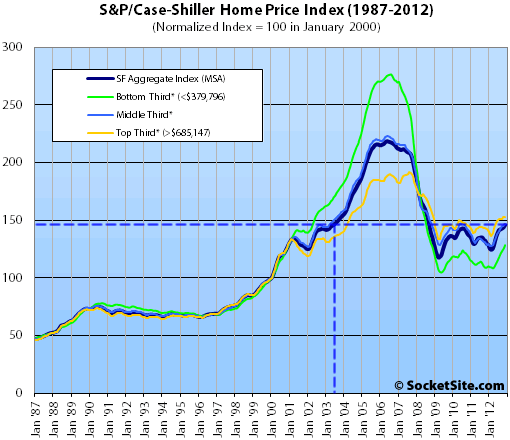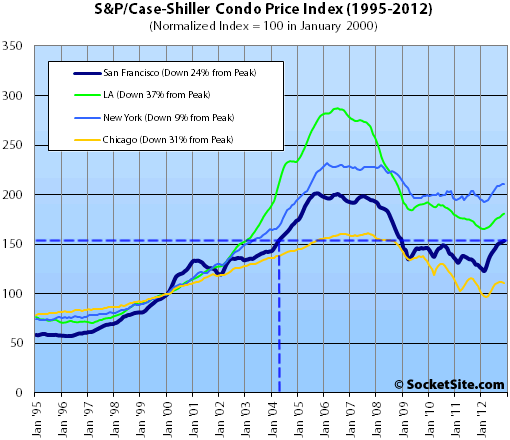According to the November 2012 S&P/Case-Shiller Home Price Index, single-family home prices in the San Francisco MSA rose 1.4% from October 2012 to November 2012 and are up 12.7% year-over-year but remain 33.0% below a May 2006 peak.
For the broader 10-City composite (CSXR), home values fell 0.3% from October to November but are up 4.2% year-over-year, down 30.1% from a June 2006 peak.
In the 12 months ended in November, prices rose in 19 of the 20 cities and fell in New York. In 19 cities prices rose faster in the 12 months to November than in the 12 months to October; Cleveland prices rose at the same pace in both time periods. Phoenix led with the fastest price rise – up 22.8% in 12 months as it posted its seventh consecutive month of double-digit annual returns.
Winter is usually a weak period for housing which explains why we now see about half the cities with falling month-to-month prices compared to 20 out of 20 seeing rising prices last summer. The better annual price changes also point to seasonal weakness rather than a reversal in the housing market. Further evidence that the weakness is seasonal is seen in the seasonally adjusted figures: only New York saw prices fall on a seasonally adjusted basis while Cleveland was flat.
Regional patterns are shifting as well. The Southwest – Las Vegas and Phoenix – are staging a strong comeback with the Southeast — Miami and Tampa close behind. The sunbelt, which bore the brunt of the housing collapse, is back in a leadership position. California is also doing well while the northeast and industrial Midwest is lagging somewhat.
On a month-over-month basis, prices rose across all three San Francisco price tiers.

The bottom third (under $379,796 at the time of acquisition) rose 2.5% from October to November (up 17.7% YOY); the middle third rose 1.1% from October to November (up 13.7% YOY); and the top third (over $685,147 at the time of acquisition) ticked up 0.4% from October to November, up 7.7% year-over-year (versus 6.2% in October).
According to the Index, single-family home values for the bottom third of the market in the San Francisco MSA are back to December 2000 levels, down 53% from an August 2006 peak; the middle third is back to March 2003 levels, down 34% from a May 2006 peak; and the top third remains at May 2004 levels, 20% below an August 2007 peak.
Condo values in the San Francisco MSA ticked up 0.8% from October to November and are up 18.7% year-over-year but remain 23.7% below a December 2005 peak.

Our standard SocketSite S&P/Case-Shiller footnote: The S&P/Case-Shiller home price indices include San Francisco, San Mateo, Marin, Contra Costa, and Alameda in the “San Francisco” index (i.e., greater MSA) and are imperfect in factoring out changes in property values due to improvements versus appreciation (although they try their best).
∙ Home Prices Extend Gains According to the S&P/Case-Shiller Index [Standard & Poor’s]
∙ While The US Index Slips, San Francisco Home Prices Gain [SocketSite]
Property prices within SF are up around 8-15% from the over 40 comps I’ve seen sell in 2012. Add that to a 10-15% YoY increase in rents and it is clear the good times are back for real estate owners.
“single-family home values for the bottom third of the market in the San Francisco MSA are back to December 2000 levels, down 53% from an August 2006 peak; the middle third is back to March 2003 levels, down 34% from a May 2006 peak; and the top third remains at May 2004 levels, 20% below an August 2007 peak.”
“good times” indeed.
“good times are back for real estate owners.”
I’ve never fully understood this line of reasoning. You buy a home, you hope it appreciates or keeps up with inflation; and pray it doesn’t depreciate. It’s not really “good times” so to speak. Maybe its good times for the real estate industry (agents, brokers, investors, builders, workers, painters, etc..) but as a homeowner I’m not really throwing any parties cause the market is hot.
I’m still surprised at how quick the market moved over such a short period of time. This sort of takes the edge off any heart warming feelings one might get from a hot market. But, not to be a total worry wart, I understand the underlying comment. 🙂
The msa is always tough to relate to because it includes the burbs and the individual markets are so extreme. A decent 3 bedroom house out in the Central Valley dropped as low as 110k, now up to 150k, while here in Frisco a 2 bedroom with no view, one parking, north of Calif st, 800k easy. For the 600k it costs for a one bedroom here, it’s difficult to even find anything that expensive in Visalia.
That trend might continue. Frisco will always remain a great place but there’s simply no reason to live in Fresno, no reason at all. I read recently it costs $1700 to rent a U-haul from California to Texas, and $600 to rent the same U-haul from Texas to California.
The 7X7 is still down from peak, but the NE corner that roughly starts at Mount Davidson is at 2007 levels or even higher in the case of a few zip codes.
As far as it being “good times for real estate owners”, consider that refis at the current rock-bottom rates are easier than 3 years ago due to a much better equity situation. It you purchased in 2007 at 6.5% and didn’t refi due to negative equity, you can now have access to 3.5% financing. That’s roughly 1/2 less in interest, or 30% less in mortgage payment for a 30-Y fixed. Good times indeed.
By the way, 1978 just called. It wants its “Frisco” back.
Hmmm. So Noe Valley is down too? Where?
When we read that a large amount of homes are sold for over asking, and short days on the market.
Other neighborhoods have similar results.
What 7×7 are you referring to again?
Remember the regular disclaimer – this data includes all the outlying counties. So the info on the tiers doesn’t really apply to most of SF, since houses here were generally in the middle and upper tiers to start with. The price losses in the lower tiers were heavily influenced by the outer suburbs. I’m in Supe District 11 (Outer Mission), and prices around here dropped to about 2002 prices from the peak, and are now back up to 2004-5 prices. But I have a cousin in Danville who saw his $1.2 mil (in 2007) house drop 50% to $850K assessed value last year – OUCH. Not sure how those are fairing now, but they have a long way to go up. And you can only imagine the decline for lower end houses out in Benicia, Vallejo and Livermore.
All is not rosy in the NE quadrant of SF. I’m still down since 2007 and can’t refi. I think my unit is doing just slightly better then the condo figure above (23.7%), perhaps only down about 17-20%. I paid the same in 2007 as the previous owner did in 2005 when he bought it.
As for not being able to refi, fortunately my ARM is now down to 3.125% for 2013, was 6.25% during 2007-2011 and down even from the 3.375% I was paying last year. I think one of the biggest factors effecting my condo’s value is that they cannot be rented out, so only people willing to buy and live in a small condo in the Western Addition would be interested. On the plus side I’m paying way less then it would cost to rent a similar apartment.
futurist, please read my first line in full. NV is in the NE quadrant I am talking about (the tip of the quadrant being roughly at Mount Davidson.
If you go south of GP or West of Twin Peaks, prices are likely to be still a bit lower than 2007. It’s 60% of SF in surface.
I’m going to just comment concerning the nationwide S&P/Case Shiller numbers, and the assumption that “good times are back for real estate owners”, but also acknowledge ahead of time that I understand ‘anon’ was talking about the S.F. MSA with that specific sentence. I think most people will also have the same idea about the national market.
Now with that out of the way, from the L. A. Times today, Home prices on the rise, but not ownership:
Emphasis mine.
All the government intervention to “assist struggling homeowners” to hang onto property that they can’t really afford is a big part of the story here, and because of that, the true price level isn’t what’s going to be the settling point when the market reached/reaches equilibrium.
Again, speaking of the national market, a lot of these increases recently are just due to the fact that investors who can get loans can get them at dirt cheap interest rates, and are bidding up prices on homes in order to either flip them or rent them out. People who are underwater are just trying to hold on until they’re above water enough to refinance.
But more Americans aren’t becoming homeowners, there’s just more opportunities for speculators and investors out there, and the price level rising is just telling us that lots of people with money are interested in income property. Good times, but mostly for people who are already comfortable.
Nice to see double digit price inflation back in the index at the end on 2012.
Its 2010 all over again!
this jives with what i was seeing. 2-3bdr flats in $750-$950K range around 2004 to 2005 prices.
Alameda county includes the worst parts of east Oakland. There are still properties there down over 50% from the peak. that is greatly distorting the numbers for “San Francisco”